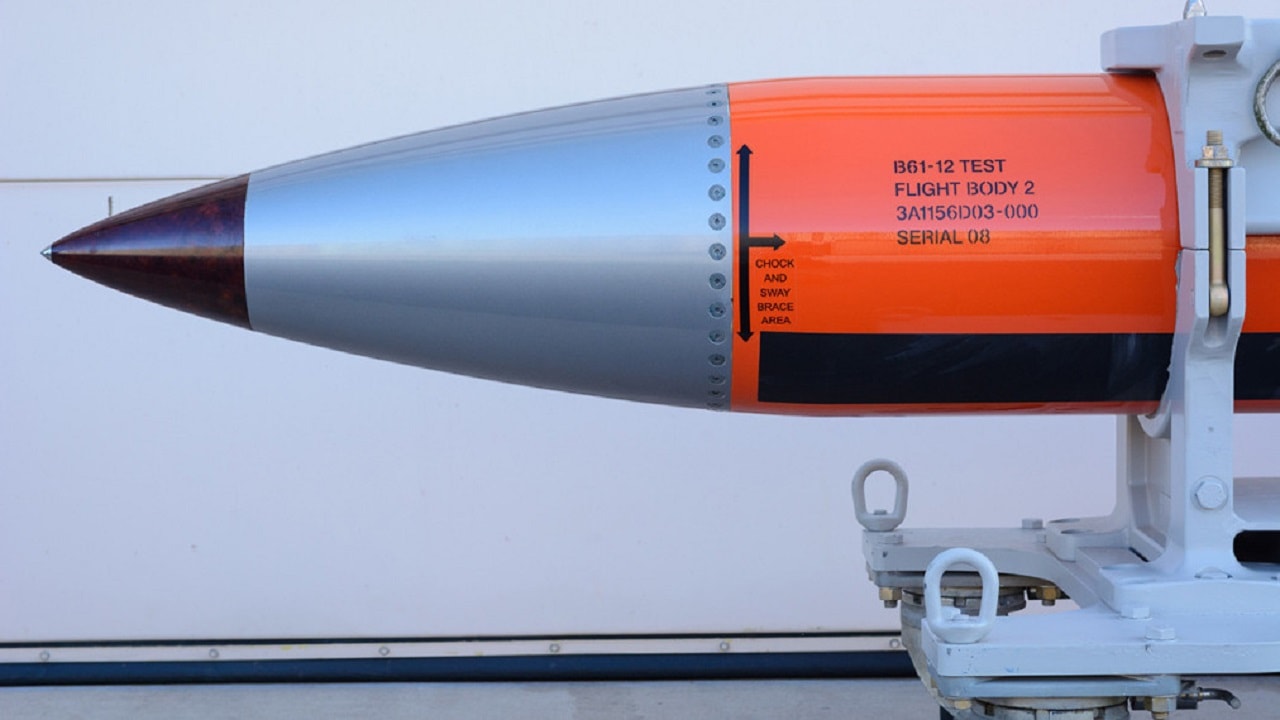Would Russia launch a tactical nuclear weapon in Ukraine? Many military analysts and policymakers have thought about this contingency with the Russian invasion going very badly. Russia, after all, has the most nuclear warheads in the world.
Tactical Nuclear Strikes
Normally, a military would use a tactical nuclear strike to break a battlefield stalemate—existing or potential—and tip the scale in its favor.
A tactical nuclear weapon can destroy even the best prepared defensive line at a moment’s notice. Although tactical nuclear weapons have less power than the atomic bombs the U.S. dropped on Hiroshima and Nagasaki, they still pack an explosive power of approximately 5,000 tons of TNT.
Normally, a military would use a tactical nuclear strike to break a battlefield stalemate and tip the scale.
For example, during the Cold War, the Fulda Gap between West and East Germany offered ideal ground for armored warfare. In the event of a war between the U.S. and NATO, the Soviet Union was planning on pouring its tank and mechanized infantry formations through the Fulda Gap to attack Western Europe.
Recognizing the threat, the U.S. had placed seven brigades to guard the 31-mile gap. Even if the Soviets sent masses of tanks and mechanized infantry, the NATO forces could delay them long enough to allow for reinforcements to arrive or to prepare other defensive positions in the rear.
But a tactical nuclear strike would obliterate the NATO forces guarding the gap and allow the Warsaw Pact divisions to pass. Further, since the strike would be tactical in nature, NATO would be less likely to respond with a strategic nuclear attack, which would cause a nuclear war and the mutual destruction of both warring parties.
In a sense, tactical nuclear weapons are intended to let a country have its cake and eat it too.
A Nuclear Attack to Break the Save Face?
Early into the war, Russian President Vladimir Putin put his nuclear forces on high alert in response to the military aid the U.S., NATO, and the European Union sent Ukraine and the unprecedented wave of sanctions that the U.S. and its allies unleashed. The move also had a domestic flavor, as Putin wanted to appear tough and capable to the Russian people and balance his miscalculation in Ukraine.
“So, on the nuclear question. . . what I would tell you is we’ve seen Mr. Putin’s announcement. We believe it’s as unnecessary as it is escalatory. But we’re reviewing and analyzing that announcement,” Pentagon Press Secretary John Kirby had said after Putin raised Russia’s nuclear posture.
The U.S. saw through Putin’s motives and didn’t raise its strategic deterrence posture.
“And I would only just tell you that as we continue to review and analyze and monitor that Secretary Austin is comfortable with the strategic deterrent posture of the United States and our ability to defend the homeland, our allies, and our partners,” the Pentagon spokesperson added.
“We believe that this is not only an unnecessary step for him to take but an escalatory one, unnecessary because Russia has not ever been under threat by the west or by NATO and certainly wasn’t under any threat by Ukraine. And escalatory because it is clearly potentially putting at play forces that could that if there’s a miscalculation could make things much, much more dangerous,” a senior Pentagon official had said.
But that doesn’t mean that the Russian leader might not resort to a tactical nuclear strike to save face.
More than a month has passed since the first Russian tanks rolled into Ukraine and the Russian military has failed to achieve any of its primary objectives. The war is going so bad for Moscow that the Russian military has changed its goals, relinquishing the capture of Kyiv and focusing on eastern Ukraine and the Donbas. Should the Russian military fails to make any considerable gains in its publicly stated goals in the Donbas, Putin and his advisers would have nothing to fall back onto.
But a tactical nuclear strike—most likely justified with some sort of outlandish excuse, including a false flag operation—would give Putin a way out.
Russian Nuclear Capabilities
When it comes to nuclear weapons, the Russian military is the most powerful in the world. Moscow has approximately 6,400 nuclear warheads. In comparison, the U.S. military can field 5,800 nuclear warheads.
The Russian nuclear arsenal is managed by the Strategic Rocket Forces, a distinct branch of the Russian military that controls the country’s nuclear triad—the ground, naval, and air components.
On the ground, the Russian military has about 310intercontinental ballistic missiles that can carry up to 1,189 nuclear warheads.
In the sea, the Russian nuclear deterrence is focused on about ten Delta- and Borei-class submarines, with each packing 16 submarine-launched ballistic missiles that have several warheads each. In total, the Russian nuclear maritime force can launch about 624 nuclear warheads.
Finally, in the air, the Russia’s Aerospace Force has between 50 and 70 strategic bombers—Tu-160 Blackjack and Tu-95MS Bear—that each can carry from 12 to 16 AS-15 cruise missiles armed with nuclear warheads.
1945’s New Defense and National Security Columnist, Stavros Atlamazoglou is a seasoned defense journalist specializing in special operations, a Hellenic Army veteran (national service with the 575th Marine Battalion and Army HQ), and a Johns Hopkins University graduate. His work has been featured in Business Insider, Sandboxx, and SOFREP.

